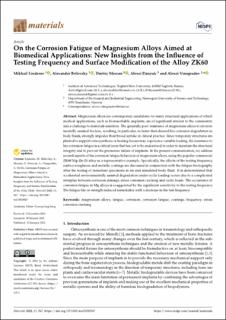| dc.contributor.author | Linderov, Mikhail | |
| dc.contributor.author | Brilevsky, Alexander | |
| dc.contributor.author | Merson, Dmitry | |
| dc.contributor.author | Danyuk, Alexei | |
| dc.contributor.author | Vinogradov, Alexei | |
| dc.date.accessioned | 2023-02-06T16:24:19Z | |
| dc.date.available | 2023-02-06T16:24:19Z | |
| dc.date.created | 2022-04-11T14:07:08Z | |
| dc.date.issued | 2022 | |
| dc.identifier.citation | Materials. 2022, 15 (2), . | en_US |
| dc.identifier.issn | 1996-1944 | |
| dc.identifier.uri | https://hdl.handle.net/11250/3048703 | |
| dc.description.abstract | Magnesium alloys are contemporary candidates for many structural applications of which medical applications, such as bioresorbable implants, are of significant interest to the community and a challenge to materials scientists. The generally poor resistance of magnesium alloys to environmentally assisted fracture, resulting, in particular, in faster-than-desired bio-corrosion degradation in body fluids, strongly impedes their broad uptake in clinical practice. Since temporary structures implanted to support osteosynthesis or healing tissues may experience variable loading, the resistance to bio-corrosion fatigue is a critical issue that has yet to be understood in order to maintain the structural integrity and to prevent the premature failure of implants. In the present communication, we address several aspects of the corrosion fatigue behaviour of magnesium alloys, using the popular commercial ZK60 Mg-Zn-Zr alloy as a representative example. Specifically, the effects of the testing frequency, surface roughness and metallic coatings are discussed in conjunction with the fatigue fractography after the testing of miniature specimens in air and simulated body fluid. It is demonstrated that accelerated environmentally assisted degradation under cyclic loading occurs due to a complicated interplay between corrosion damage, stress corrosion cracking and cyclic loads. The occurrence of corrosion fatigue in Mg alloys is exaggerated by the significant sensitivity to the testing frequency. The fatigue life or strength reduced remarkably with a decrease in the test frequency. | en_US |
| dc.language.iso | eng | en_US |
| dc.publisher | MDPI | en_US |
| dc.rights | Navngivelse 4.0 Internasjonal | * |
| dc.rights.uri | http://creativecommons.org/licenses/by/4.0/deed.no | * |
| dc.title | On the Corrosion Fatigue of Magnesium Alloys Aimed at Biomedical Applications: New Insights from the Influence of Testing Frequency and Surface Modification of the Alloy ZK60 | en_US |
| dc.title.alternative | On the Corrosion Fatigue of Magnesium Alloys Aimed at Biomedical Applications: New Insights from the Influence of Testing Frequency and Surface Modification of the Alloy ZK60 | en_US |
| dc.type | Peer reviewed | en_US |
| dc.type | Journal article | en_US |
| dc.description.version | publishedVersion | en_US |
| dc.source.pagenumber | 21 | en_US |
| dc.source.volume | 15 | en_US |
| dc.source.journal | Materials | en_US |
| dc.source.issue | 2 | en_US |
| dc.identifier.doi | 10.3390/ma15020567 | |
| dc.identifier.cristin | 2016752 | |
| cristin.ispublished | true | |
| cristin.fulltext | original | |
| cristin.qualitycode | 1 | |

